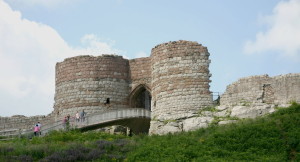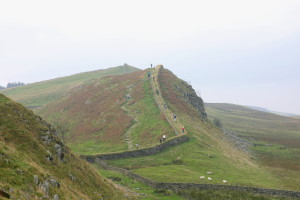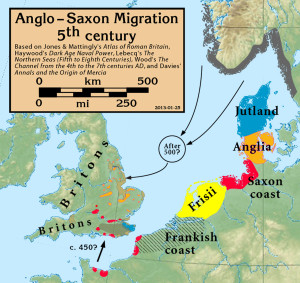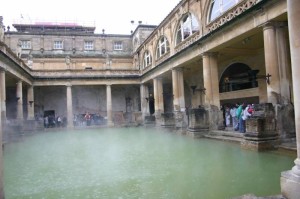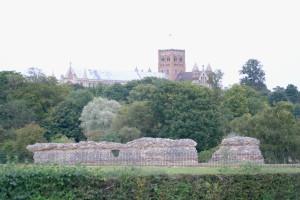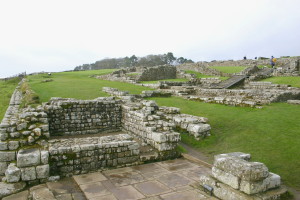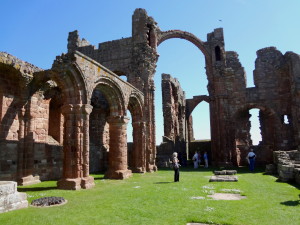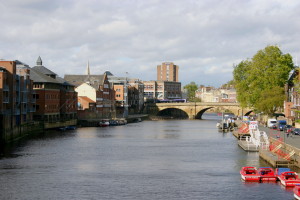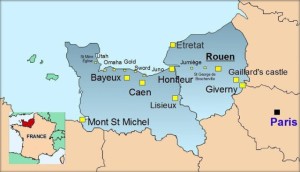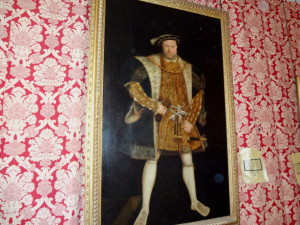I stood in front of the skeletal remains of St. Andrew’s Cathedral and wondered how this beautiful house of peace overlooking the North Sea could ever have been burned to the ground. I felt the same sense of loss as I walked through the ruins of the Abbeys in Leeds, Lindisfarne and other locations.
Huge rock castles made by forced labor to build fortresses for the rich and powerful lay in piles of stone. The ruins lay open like a mortal combat wound. Over the centuries, the smaller rocks were hauled off by local farmers for fences and used by engineers to build roads and homes. Today, the old ruins serve as picnic areas for families on the weekends and as tourist locations for those interested in history and architecture.
Hadrian’s Wall was the northern most point of the Roman Empire, 2,000 years ago. The Emperor Hadrian had a fourteen foot high and eight feet wide stone wall built 73 miles from one sea to the other to keep out the hordes from the north that were a threat to Roman lands in the south of Britain. There were elaborate rock forts crafted along the wall to store supplies and house soldiers. Today, there are still places where the wall stands after 2,000 years, but it is less than half the original size. The rocks were used over the centuries after the Romans left to build roads, homes and fences.
Modern Britain has been built around many monuments important to Western Civilization. Some have been restored; others lie in ruins, but remain open to the public. A few are still in use today, mostly as residences or places of business.
I have been to England three dozen times on business and personal travel. It wasn’t until I lived there and learned the history of Britain that my eyes were open to the wonders of this great land. Understanding the complex history of Britain is the key to understanding every major tourist attraction in Great Britain. Almost as interesting as the buildings themselves are the reasons for why a structure was built at that location, the history of the structure and why it was eventually laid in ruin. Almost all major tourist attractions were either the object of ruin, were damaged in fire or by war or were neglected and restored over time.
First Inhabitants
As tribes began to move west and north from the Mediterranean Sea to populate Europe, they found the British Isles. No land truly has an original population. People have to come from somewhere else, but who were the first known natives of what is today Britain? More than likely it is the people known today as the Welsh, descendants of the Celts.
The ancestors of today’s man first inhabited Great Britain in 12,000 BC. After the last major ice age, the climate became warmer and more hospitable. The period between this time and that of the Romans entering Great Britain in 43 AD was known as the Stone Age. None of the pre-Roman inhabitants had any known surviving written languages. To understand life during this period, archaeologists have to rely upon archaeological finds.
The last centuries prior to the Romans arriving in Britain saw an influx of Germanic-Celtic speaking people from Gaul, modern day France and Belgium. They were being pushed further West by the expansion of the Roman Empire.
The Romans
Some historians believe that it was the influx of refugees from continental Europe that caused Rome’s interest in Britain while others believe it was large mineral reserves. Britain was not conquered easily by the Romans. Julius Caesar had already invaded Britain in 55 and 54 BC with the aim of conquest. Rebellion in Gaul, present day France, pulled him away from Britain before victory could be attained from the British guerilla resistance.
The Emperor Claudius led the Roman troops on an invasion of Britain in 43AD with 40,000 soldiers. He led the battle at the enemy capital himself at Camulodunum (today Colchester). It took another 100 years for the Romans to quiet the opposition and defeat the mysterious and ferocious blue-painted warriors.
Between 120 and 130 AD the Romans pulled back slightly from the north of Britain to provide more troops elsewhere on the continent as the empire was under attack. The Emperor Hadrian built a wall of stone, earth and timber that included forts, observation turrets and milecastles. It housed approximately 8,000 Romans.
For over 350 years the Romans remained dominant. Settlements of craftsman or traders grew up around the forts sustained by army contracts and soldiers’ pay. Local farmers supplied grain, meat, leather, wool, beer and other essentials. In the southeastern part of Britain, towns and villages began to take on a look that was distinctly Mediterranean. Iron Age tribal centers were redesigned as Roman towns. Celtic warriors and druids turned into Romanized gentlemen. A new upper class was born. The empire was ruled from the towns where councils were formed responsible for tax collection and keeping the peace.
The end of Roman expansion meant an end to an empire built on war treasure. Emperors increased taxes and encouraged the army to take what was needed from the land. The burden became a strain for the provinces and slowly ate away at the empire’s economic vitality. In the meantime, Rome’s enemies were gaining in strength, especially the Germans and Goths who ruled central Europe.
During this time, Britain was repeatedly raided by the Pics from the north, the Irish from the West and the Anglo-Saxons in the south. Roman troops were just too stretched to hold the lines. When Rome was attacked troops were taken from Britain to defend the homeland. By 425 AD Britain had ceased to be in any sense Roman. Britain was left to manage itself, creating a leadership and military void.
After the Romans
In response to a request for military support, Roman Emperor Honorious told the British people that they would have to defend themselves. The next 200 years are the least recorded in British history. Most inhabitants of Britain at this time were Romanized, especially in urban centers, but by blood they were Celtic. The local chieftains who played an active role in working with Rome in the government of their territory did their best to lead the country once the Romans were gone. Nevertheless, cities began to deteriorate and the population overall of the island may have declined. By this time, more Germanic people from the Saxon tribe in Europe were beginning to settle on the east coast of Britain.
The economy and political structure of Britain didn’t immediately collapse after the pull-out of the Romans. Although there was no more Roman coins minted in Britain, coins stayed in circulation for a least a century. Barter became more popular during post Roman Britain after the coinage became debased.
All remnants of centralized governments ended when the Romans left Britain. The country rapidly dissolved into rival factions. Life certainly wasn’t easy, but life in British Romano society flourished.
Vortigen declared himself High King of Britain in 425 and invited Saxon warriors to fight against invasions from the Scots and the Pics. The Saxons were given land in exchange for their support giving them a foothold for the first time in England, much to the displeasure of some British. Eventually, the Saxons desired to expand and were at war with the British.
In a sense, the Anglo-Saxon conquest began when the Romans left Britain, but it was a slow process that lasted almost three hundred years. There was no single leader or groups spearheading the invasion. Rather it consisted of smaller war-bands and smaller family groups in search of farmland and hunting grounds and they were willing to fight for it.
Around 550 AD the wars began again with the Germanic tribes, with a stronghold in the east, moving the Celts to the west. What began these wars is not documented, but Britain came under the rule of the Anglo-Saxons by 600 AD. Many Brits pushed out of their homes moved to Brittany, France while others pushed into the mountains of the west into what is Wales and Cornwall today.
Although historians give these conquerors the name Anglo-Saxon, in truth they were from a variety of Germanic tribes including Jutes from Denmark, Franks from Gaul, Frisians from the Netherlands and Angles from Norway. The Angles gave their name to England, Angle-Land.
Viking Age of Invasion
The Vikings first invaded in the north at Lindisfarne. This period of time was later known as the Viking Age of Invasion. By the last decade of the 8th century, Viking attacks in small, but highly planned attacks were regular in northern England. In 865, the Vikings sailed into York and captured the strategically important northern city. Northumbria became a Danish (Viking) stronghold in the north dominated by “Danelaw” with a puppet British leader as King. The Danes had considerable rule over the north while the Anglo-Saxons controlled the south.
Anglo-Saxons, Danes and the Normans
The Viking presence in England dwindled in 1066 after losing their final battle against the army of King Harold at Stamford Bridge. Nineteen days later the Normans, themselves descended from the Vikings, invaded England and defeated the weakened English army at the Battle of Hastings. King Harold rushed from his victory over the Danes in York pushing his army to the limit as word reached of the invading Normans. The English King was killed during the battle and a Norman, William the Conqueror, became the King.
Normandy was a province in north-west France who was initially populated by Celts. It was Roman territory after 98 AD, until the Romans pulled out. Towards the end of the 8th century Viking raids devastated the region. In attempt to reach peace the Vikings were given a territory, called the Duchy of Norman, which was established in 911 AD. Over the next 150 years the Danes and the Celtic/Germanic tribes intermixed into what became the Normans.
The Normans
William the Conqueror had a claim to the throne of England and was also Norman. His grandfather’s sister was the mother of Edward the Confessor, the childless King of England. He had previously promised William succession to the English throne. However upon his death in 1066, his brother-in-law Harold Goodwin claimed the throne of England for himself, despite an oath he had made to support William as King. A council of English Lords supported Harold as the thought of a Norman who spoke French, and no English, becoming King of England was reprehensible. Outraged, William decided to invade England and claim his throne.
William was the illegitimate child of the Duke of Normandy, Robert I, who died in 1035 returning from a pilgrimage in Israel. At age 8, William became the Duke of Normandy. With the help of the King Henry I of France, William was able to survive rebellion by his barons and severe violence in the region before gaining control. By 1064 he had gained firm control of his Duchy and won two neighboring provinces – Brittany and Maine.
William gathered an army, but was delayed due to weather for almost two weeks. In a stroke of luck for him, the Vikings attacked England in the north. King Harold and his brothers were prepared for William’s landing but had to rush to the north to fight the Danes. After a huge victory at Battle of Stamford Bridge, the King rushed his men southward again to meet William’s army. Exhausted, William won the battle by killing King Harold and his two brothers. There was no one of any consequence to further raise an army against William the Conqueror.
Over the next five years, William declared more and more land as his personal property and gave it to his Norman followers who imposed their unique feudal system. Eventually, Normans replaced the entire Anglo-Saxon aristocracy. William retained most of the country’s institutions and ordered a detailed census to be made of England and his new wealth. The book, called the Domesday Book, still gives us one of the rare and interesting insights into life during this period of time. It is still in the public record office in London.
William died in France in 1087, having spent little time in England. He had four daughters and four sons and every monarch of England since has been a direct descendant. He never spoke English and was illiterate, yet he influenced the English language more than anyone before or since by adding French and Latin words to the English dictionary.
The people of Wales and Cornwall are most likely the descendants of the original Gaelic Celts who first settled in Britain. The Romans had influence on the blood lines of Brits as well as the Vikings, the Anglo-Saxons and the Normans. Almost all of the historical sites you see will be from one of those periods and have something to do with key people from these different societies.
To this day there are differences in northern England and southern England largely due to the Viking influence on culture and language in the north and Anglo-Saxon/Norman influence on the south. Much like the Yankee and Rebel rivalries that can still exist in America, Londoner’s consider Mancunians (people from Manchester) as speaking guttural, or even in an uneducated manner. The southern part of England is typically seen as more “posh” or stylish than the north. Of course all this depends on which side you are on, but cultural and historical differences remain.
The Church
Although the Vikings and the Anglo-Saxons were pagans, England was largely a Christian nation beginning with the conversion of the Romans to Christianity. Over time, even the Vikings and Anglo-Saxons were converted to Christianity. However, the church played a significant role, beginning in medieval times, with many of the monuments, castles, abbeys and other historical locations you will visit in England. It is impossible to leave this influence off of the history of Great Britain.
As a result of St. Augustine’s mission to England in 597, the church in England came under the authority of the Pope. Under King Henry VIII’s rule, the church separated from Rome and formed its own church leadership under the Bishop of Canterbury and the King of England. Henry was pursuing a divorce after marrying his dead brother’s wife, Catherine of Aragon, who was unable to provide him with a male heir. The Pope refused to grant an annulment and although it caused great distress in England, Henry was only happy to end the Pope’s power and influence and use the money from the church for his monarchy. The Archbishop of Canterbury was selected as the monastic head, or primate, of the Church and as Henry appointed the Archbishop to the post, he was granted a divorce.
Henry’s separation from the Church of Rome began what is called the English Reformation. However, in 1555 Henry’s daughter with Catherine of Aragon, Mary I, became Queen and the Church of Rome was fully restored. After Mary’s death, the daughter of Henry VIII and Anne Boleyn, half-sister to Mary, rejected Rome once again and restored the Reformed Church of England. Catholic and “Reformed” factions continued to fight across England. It ended with the “Elizabethan settlement” which developed the understanding that the church was to be both Catholic and Reformed.
Religious history is long and complicated, but its impact on the history of England and its historical sites is significant. King Henry VIII was disgusted with some of the monasteries he uncovered and closed down many of them. He persecuted some monks and religious orders for not following proper Church teachings. Monks and heretics were imprisoned, burned at the stake or executed.
His daughter from his marriage, Mary, was known as Bloody Mary to the English people. She was intent on bringing back the Church of Rome, for whom her mother devoutly followed, back to England by force if necessary. Famous protestant reformers such as John “Thomas Matthews” Rogers (printer of the Matthews-Tysdale Bible) and Thomas Cranmer (Archbishop of Canterbury) were both burned at the stake. Mary went on to burn reformers at the stake by the hundreds for the crime of being a Protestant. She destroyed Protestant abbeys and monasteries across England, such as St. Andrews and Leeds.
Wars and Civil Wars
One beautiful Sunday afternoon after first arriving in England to live, I went to the Internet to find the closest castle to my new home. I spent the day at Beeston Castle in the county of Cheshire, just south and west of Manchester. The castle was originally built in 1260 and once owned by royalty – King Henry III. However, it was “slighted” on Cromwell’s orders after the Civil War and remains in ruins today. “Slighted” means partially destroyed so it could not be used as a stronghold. Many castles were burned and large sections of stone walls were thrown down to keep militaries from using them.
The period of time between 1642-1651 saw a series of armed conflicts and political challenges between Parliament (Roundheads) and royalists (Cavaliers). The conflict was specifically between the monarchy (Charles I and Charles II) and the Parliament. The civil war ended with the Parliamentary victory at the Battle of Worcester in 1651. It was during this dark time in English history that many castles were damaged and destroyed. Some remain in ruins, others have been restored, but many were severely damaged.
Charles I was executed and his son, Charles II, exiled and replaced with Commonwealth of England and then a Protectorate, under Oliver Cromwell’s personal rule. The monarchy was later restored and Cromwell’s body was dug out of the ground and publicly hung. Constitutionally, the wars established the precedent that an English monarch cannot govern without Parliament’s consent.
Summary
History plays an important role in every historical attraction visited. Understanding the role a historical location played in history enables the visitor to get the full enjoyment from the site. British history is long and can be complex, but armed with a little knowledge will help the tourist get maximum understanding of the attraction they are visiting. It will give you greater insight into the meaning of events that occurred at the location.
